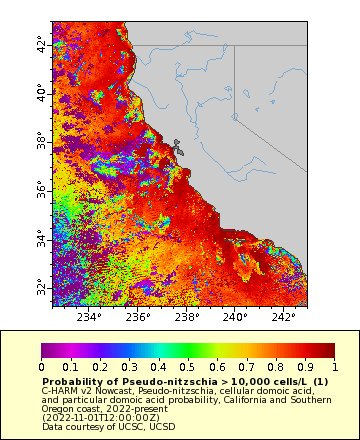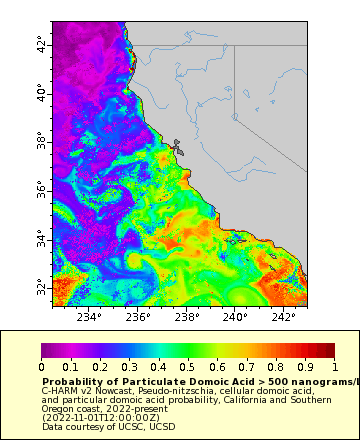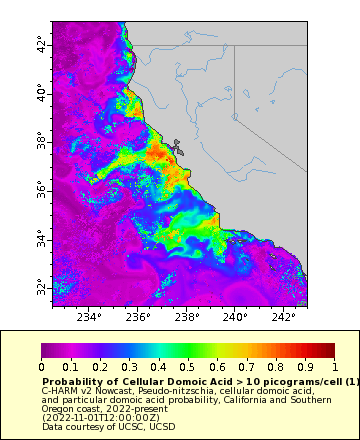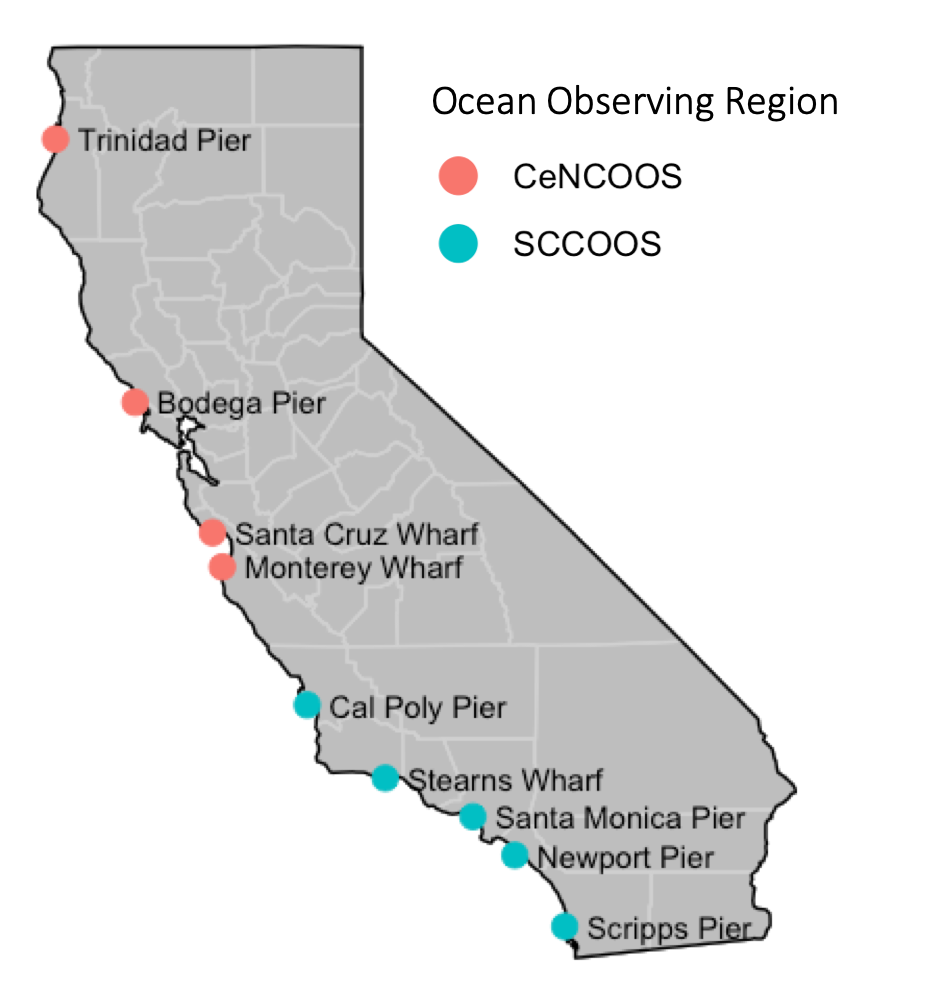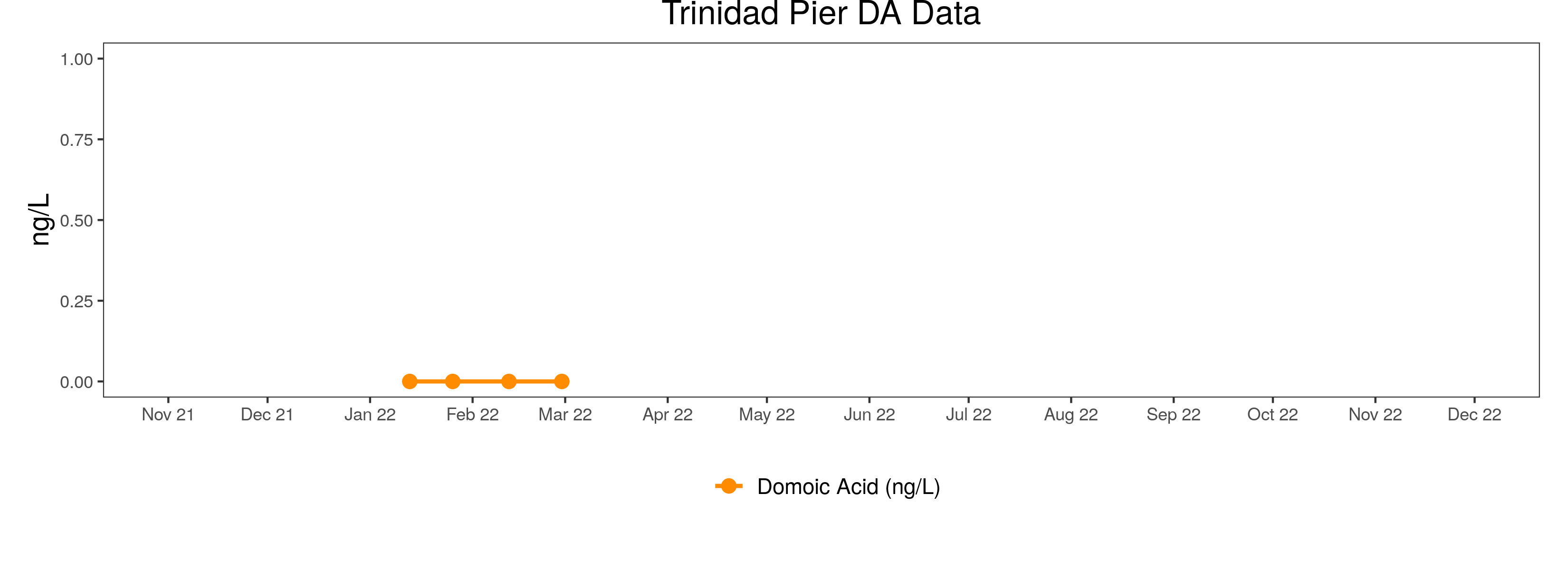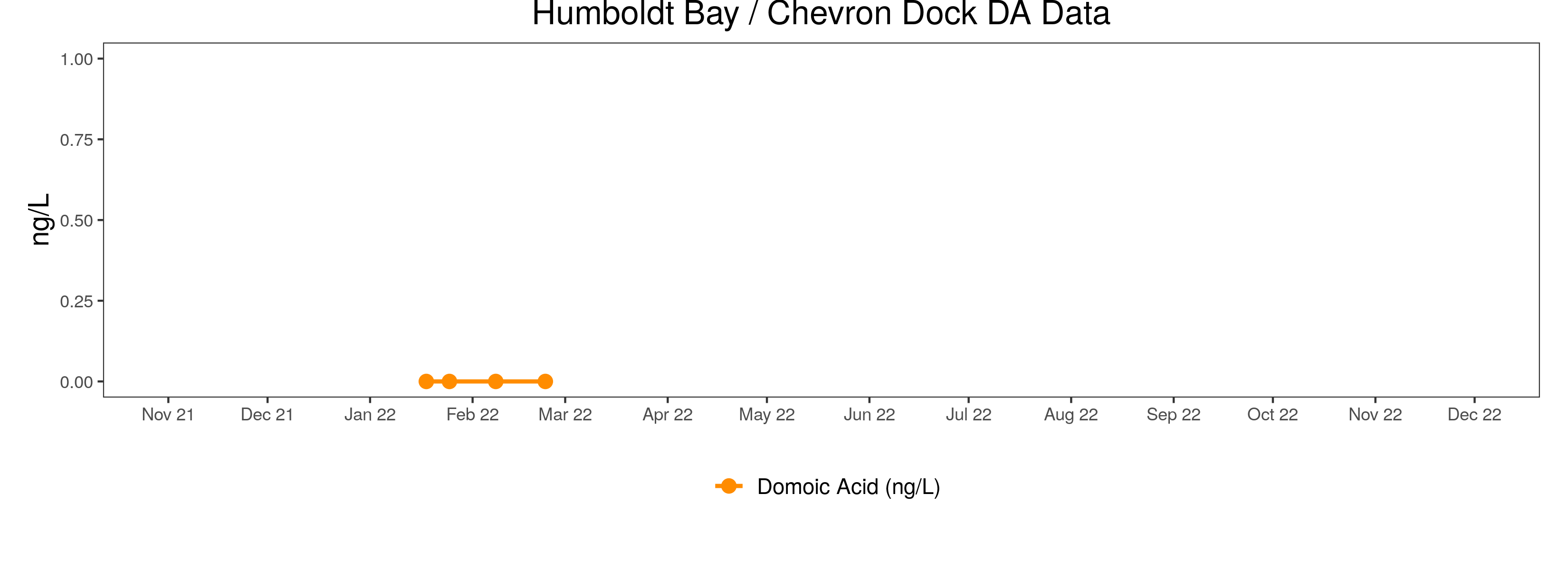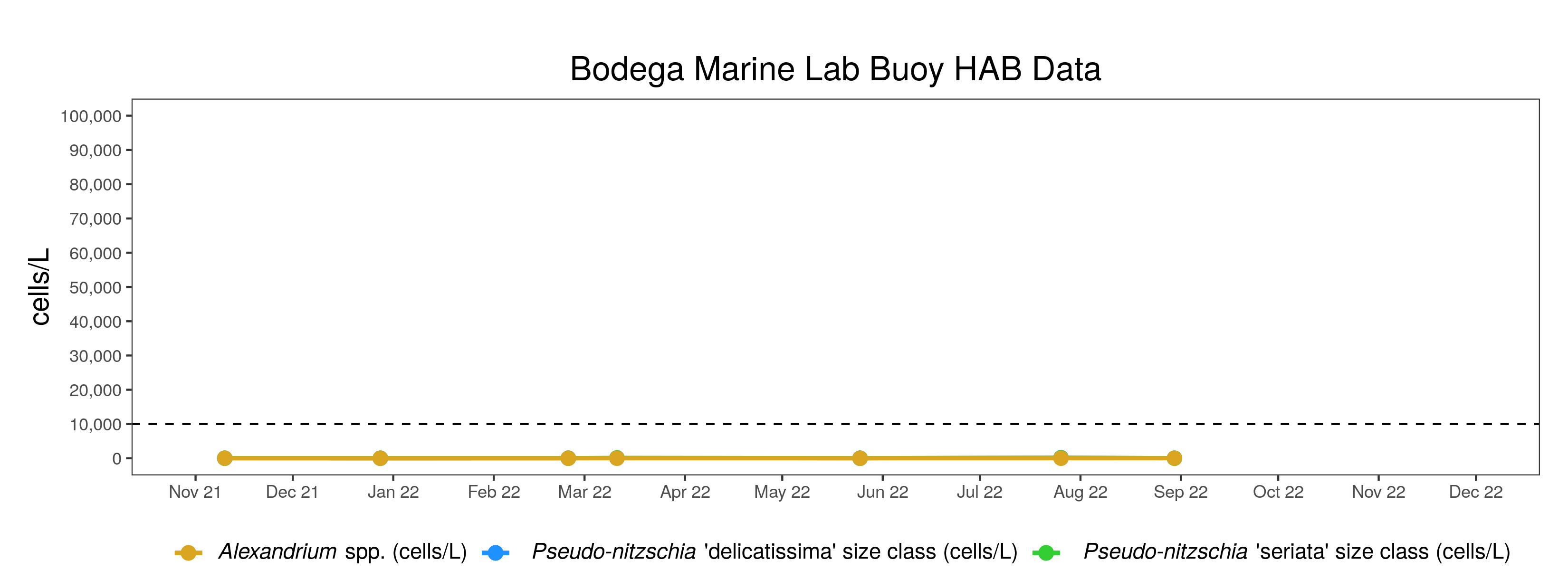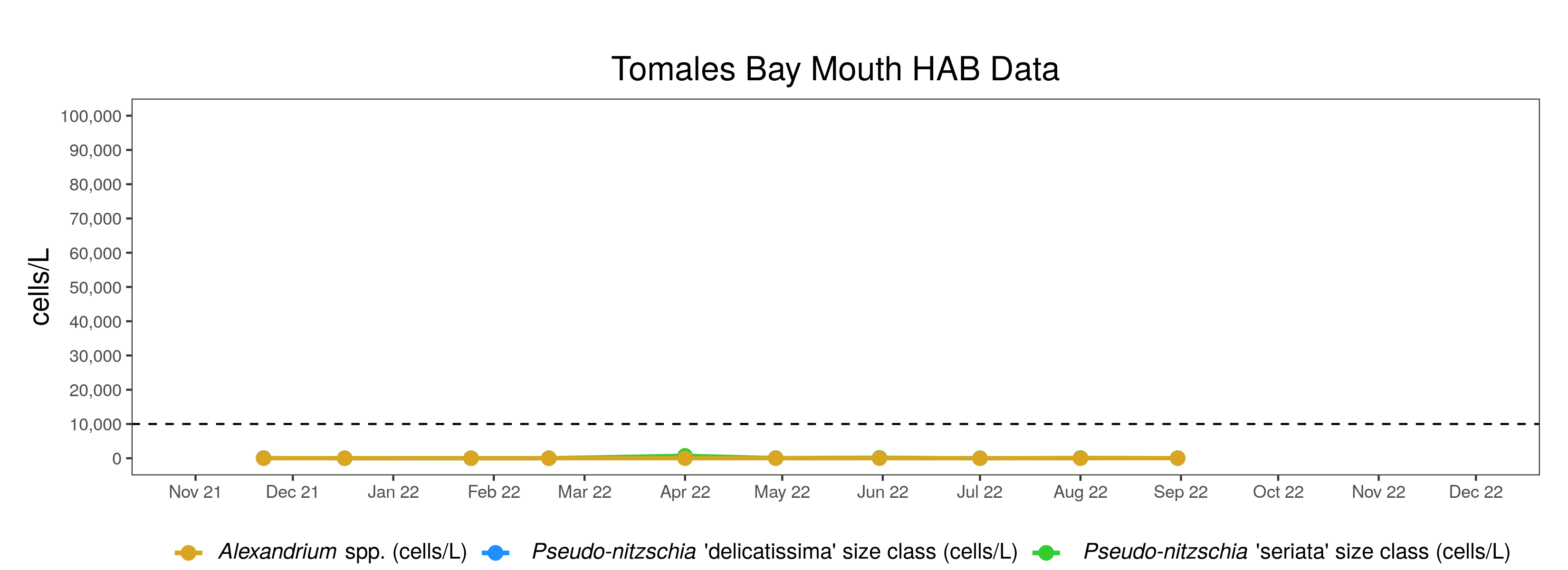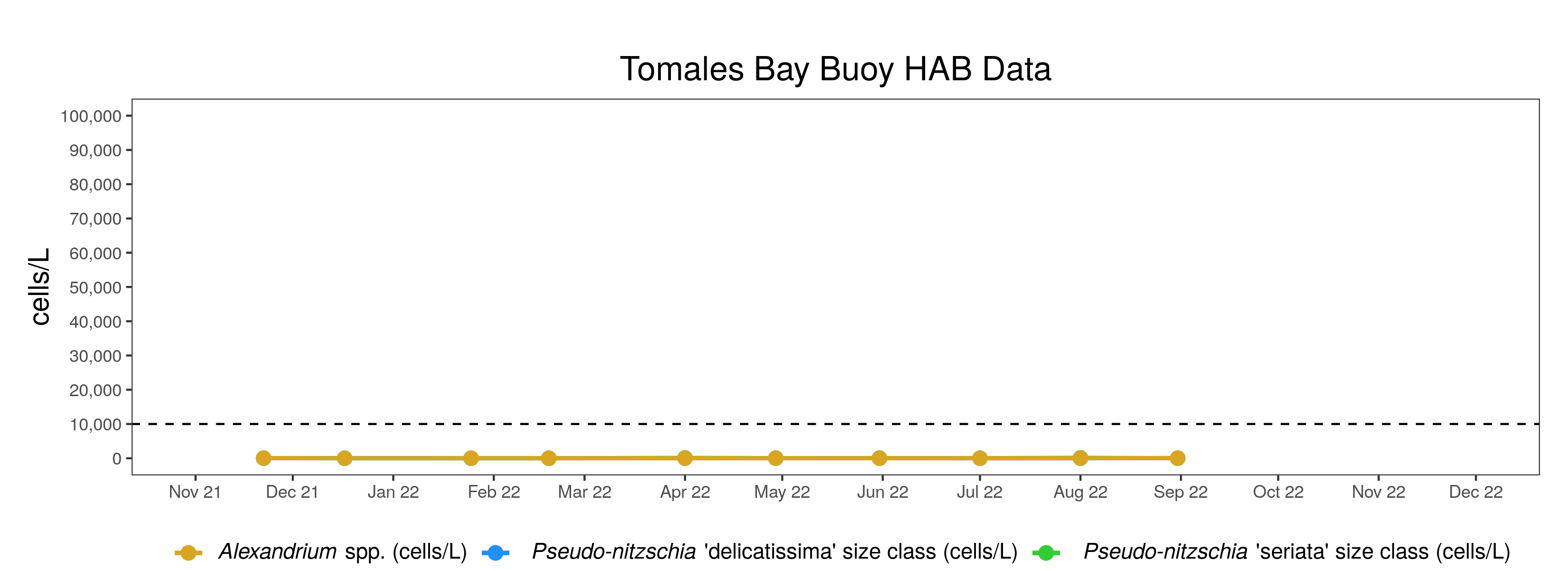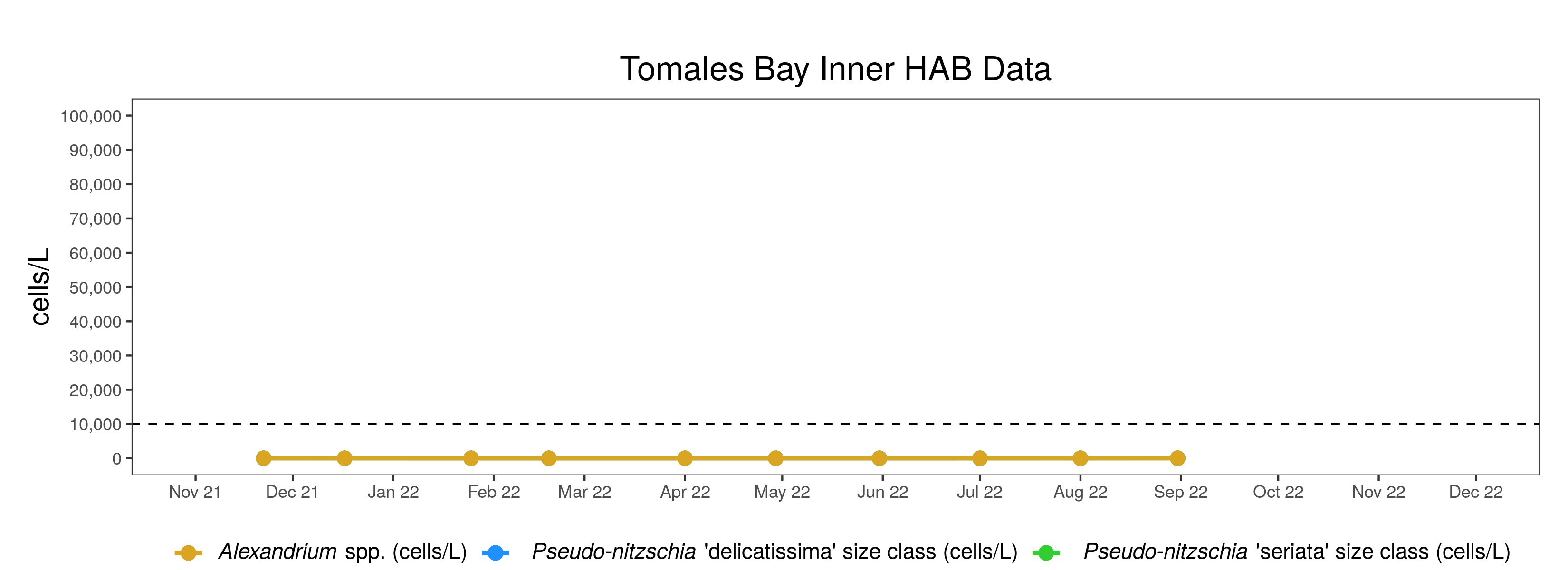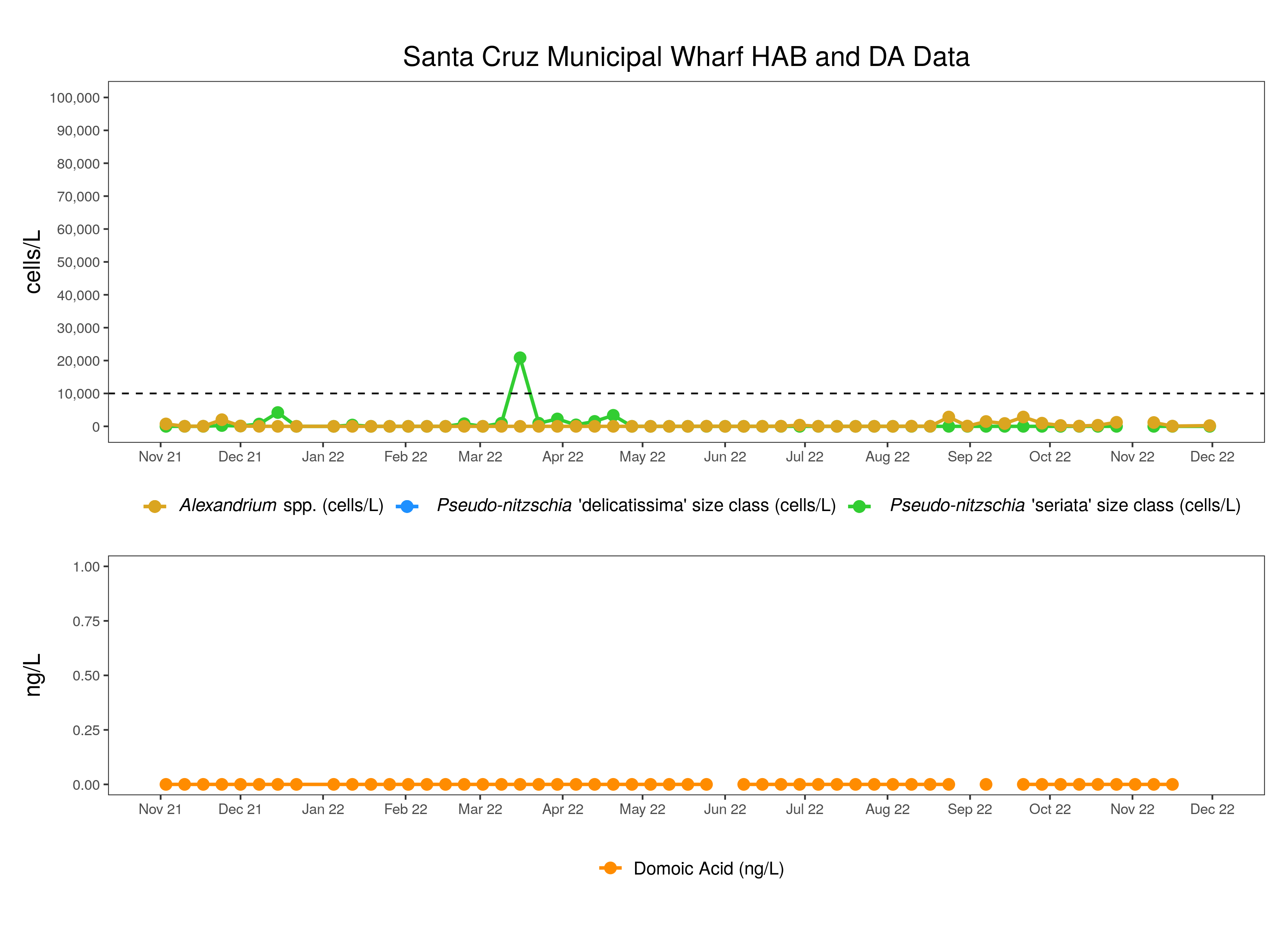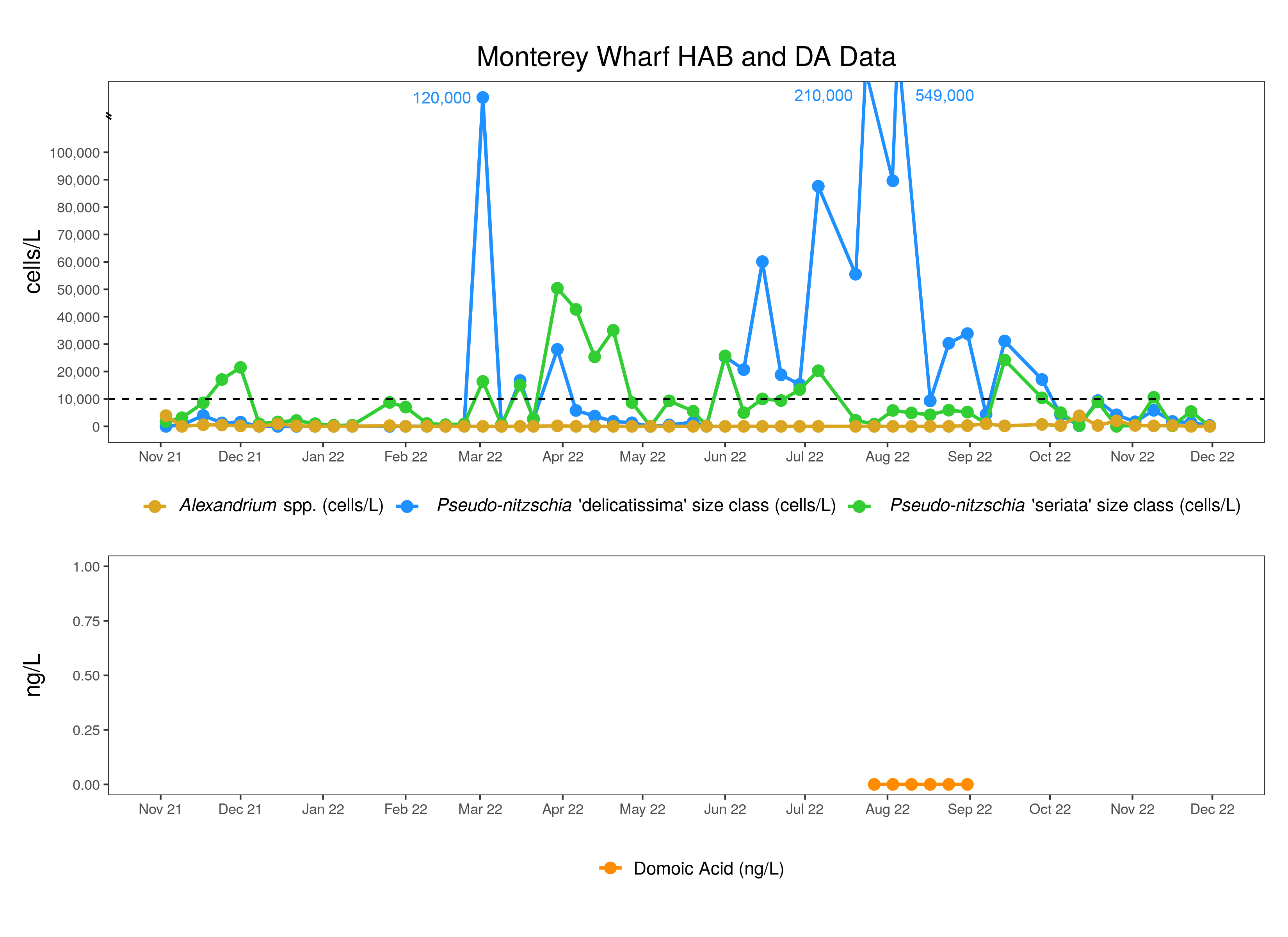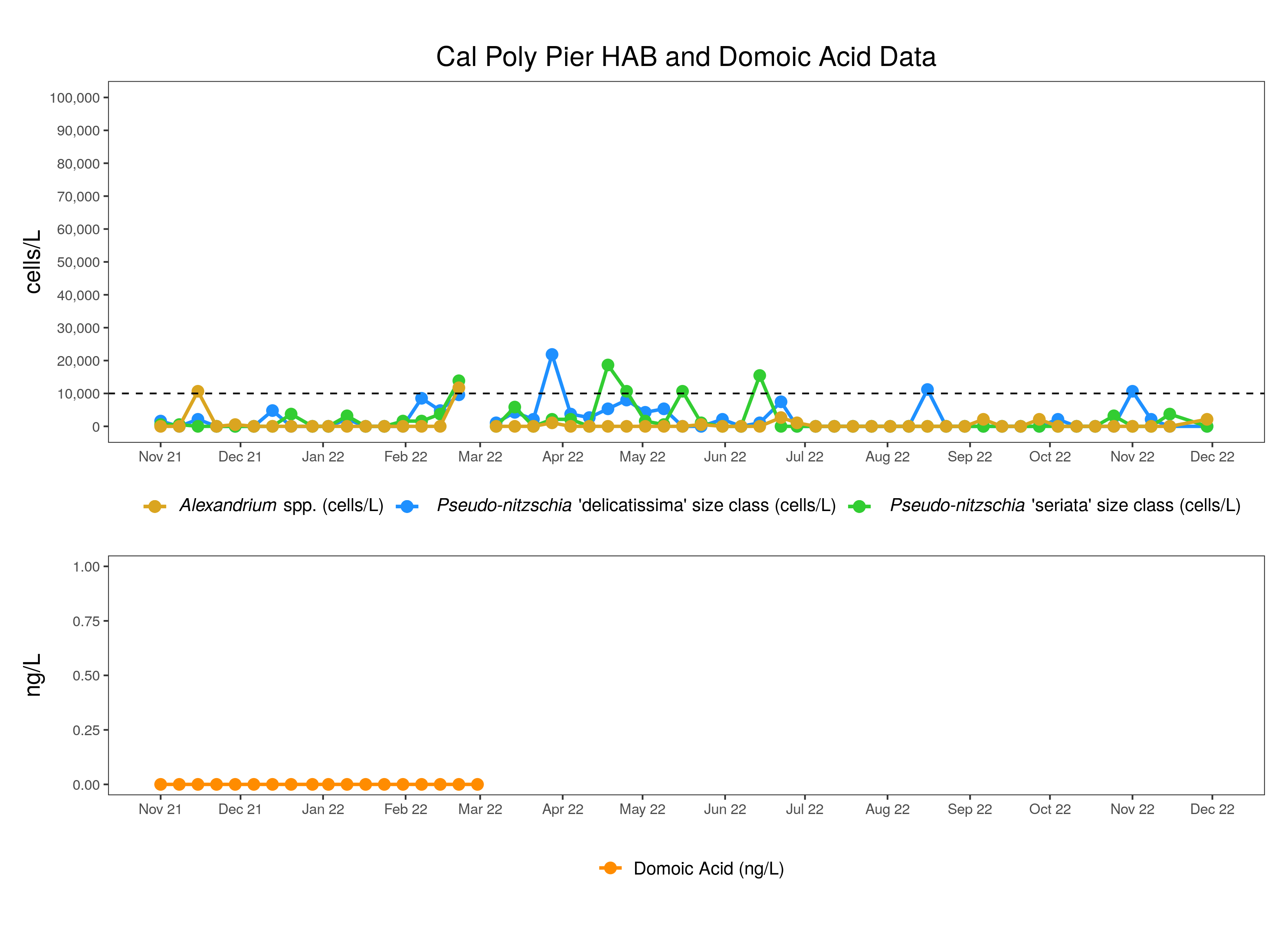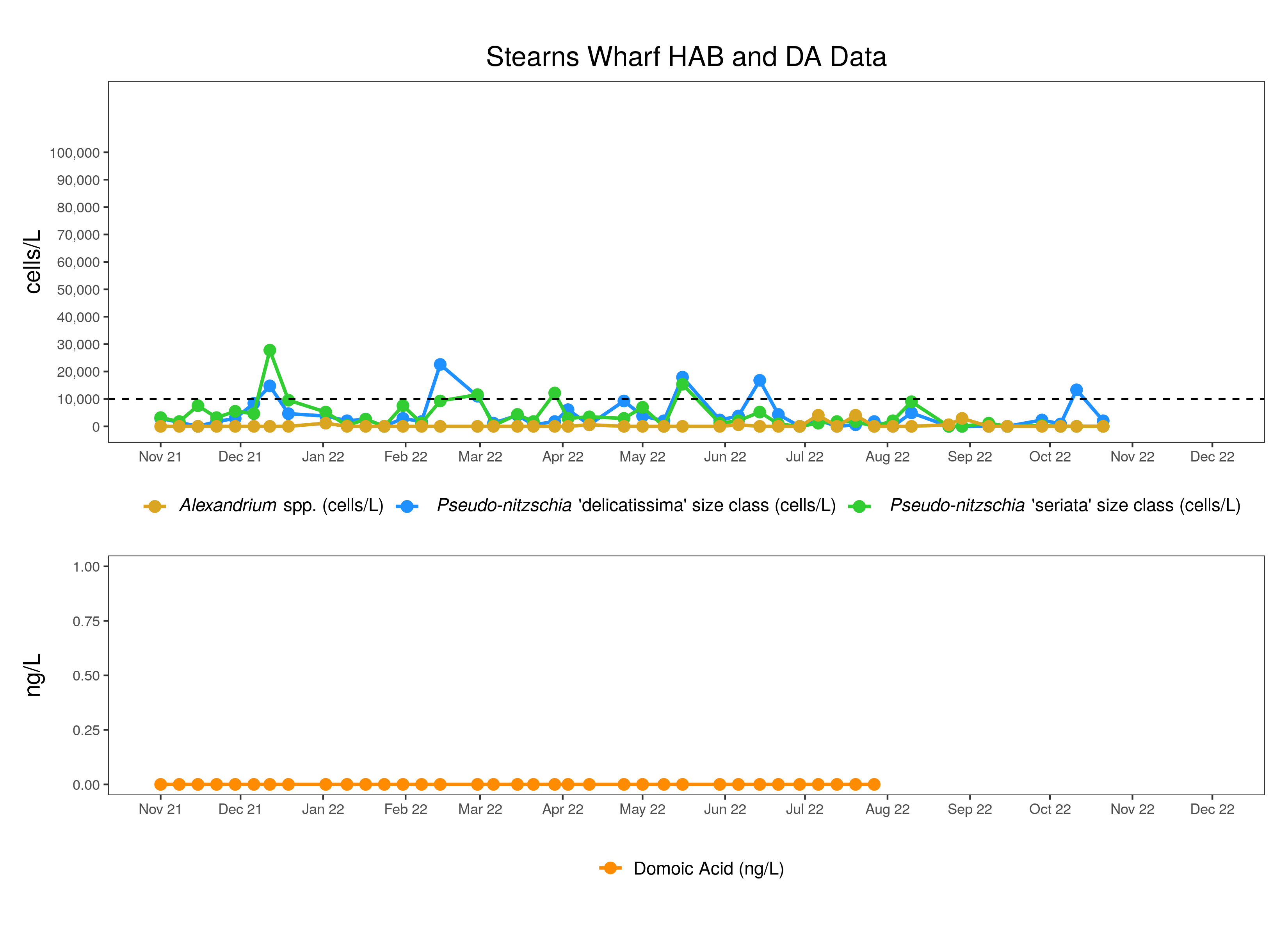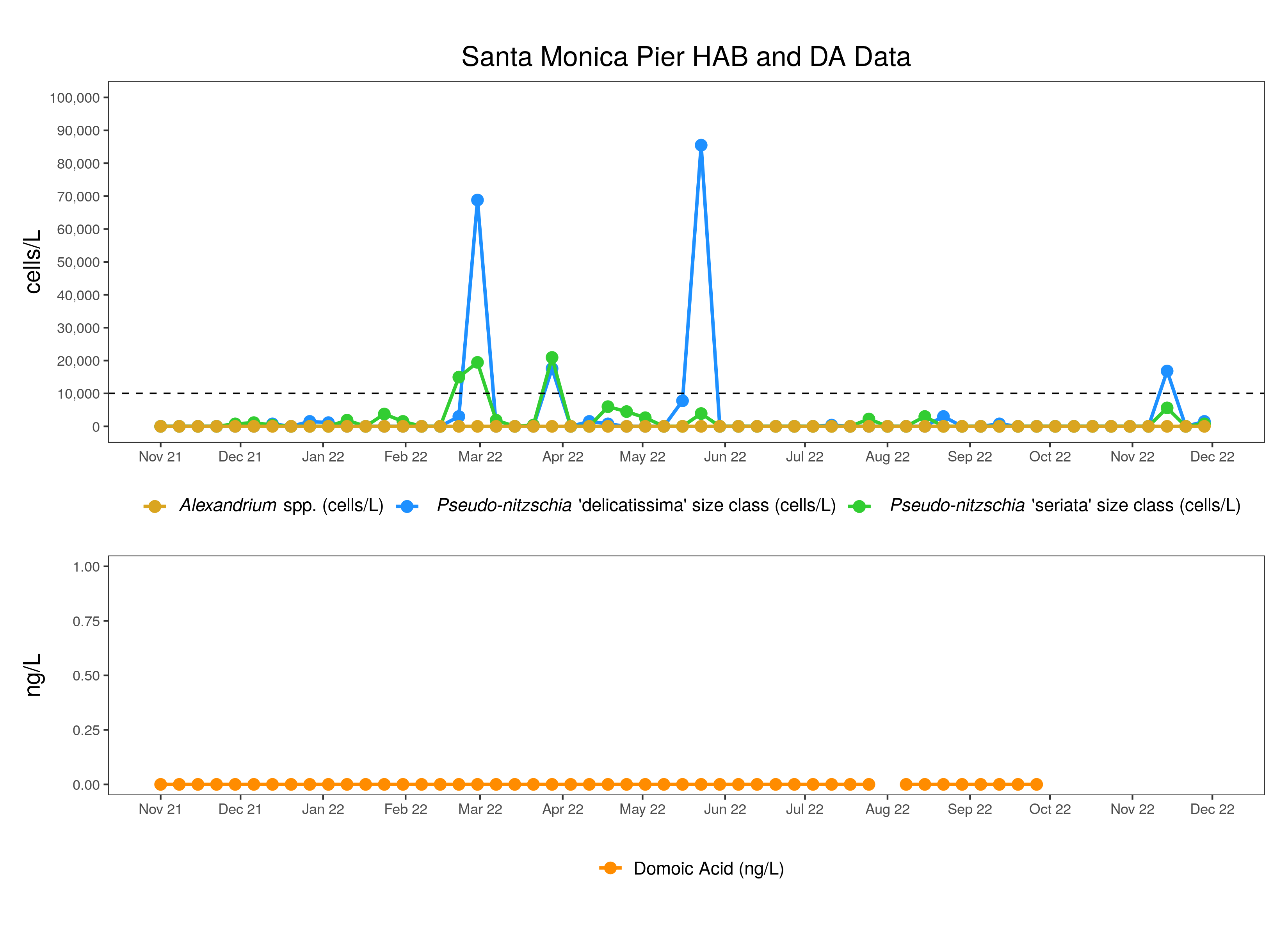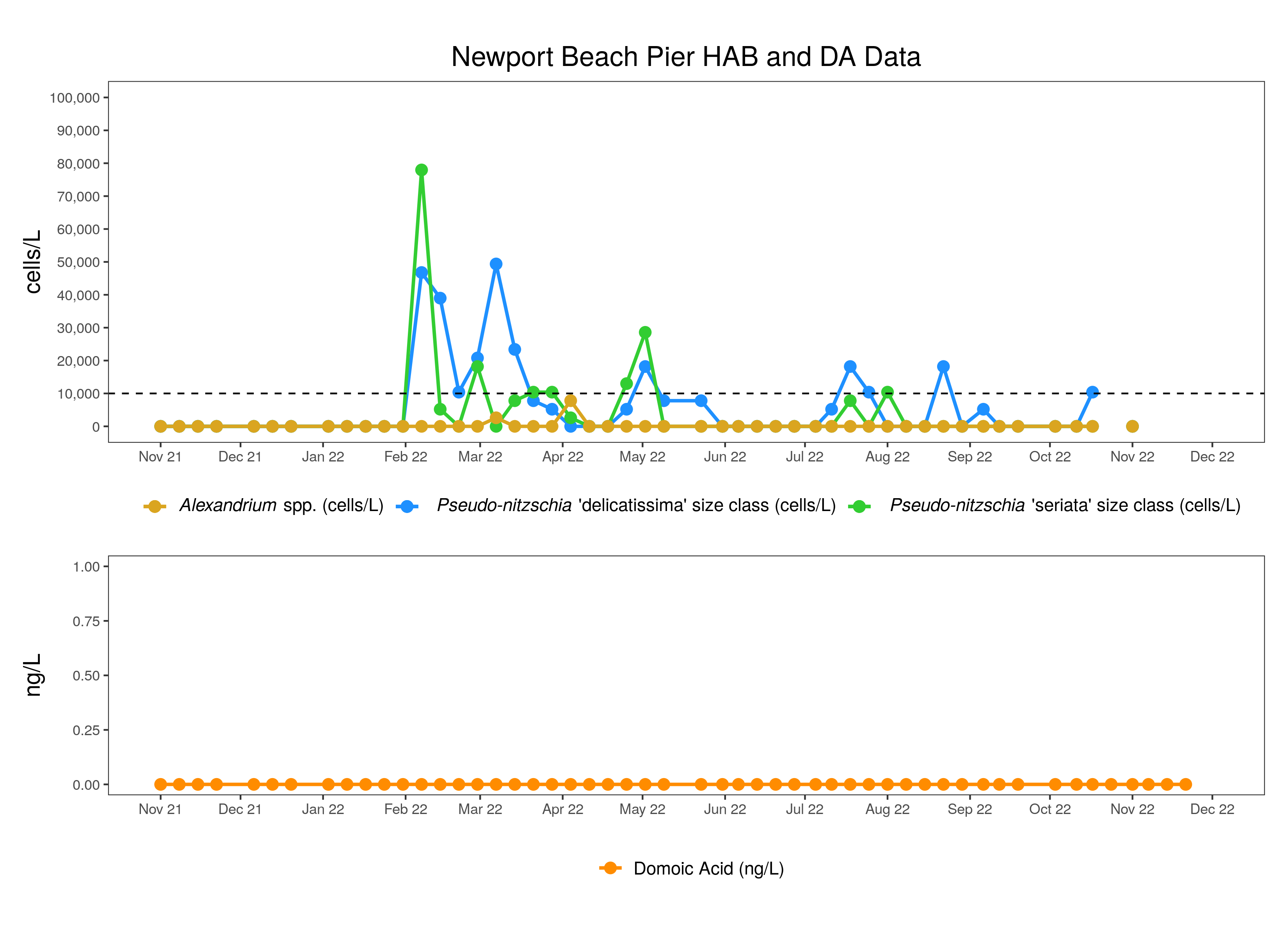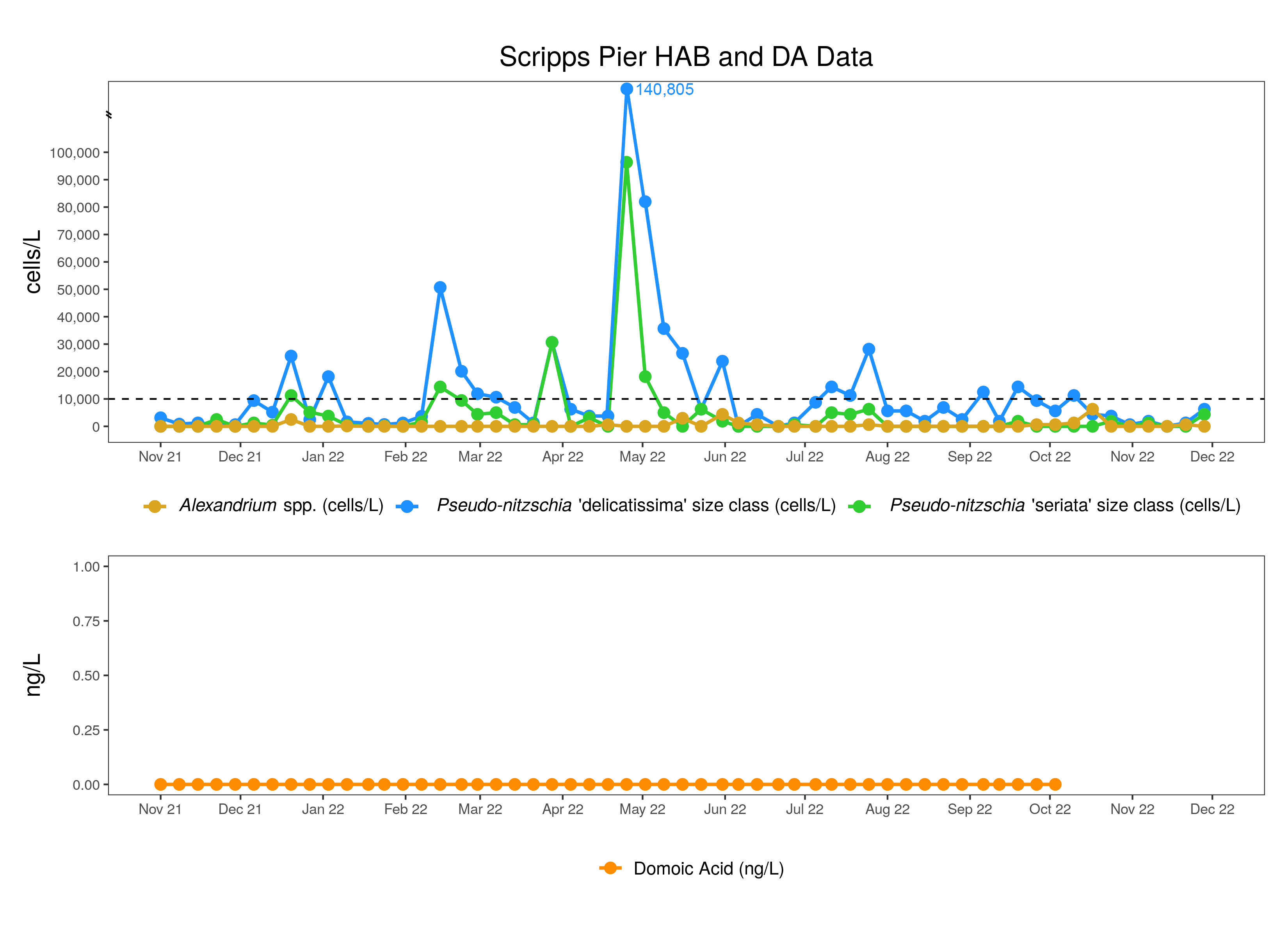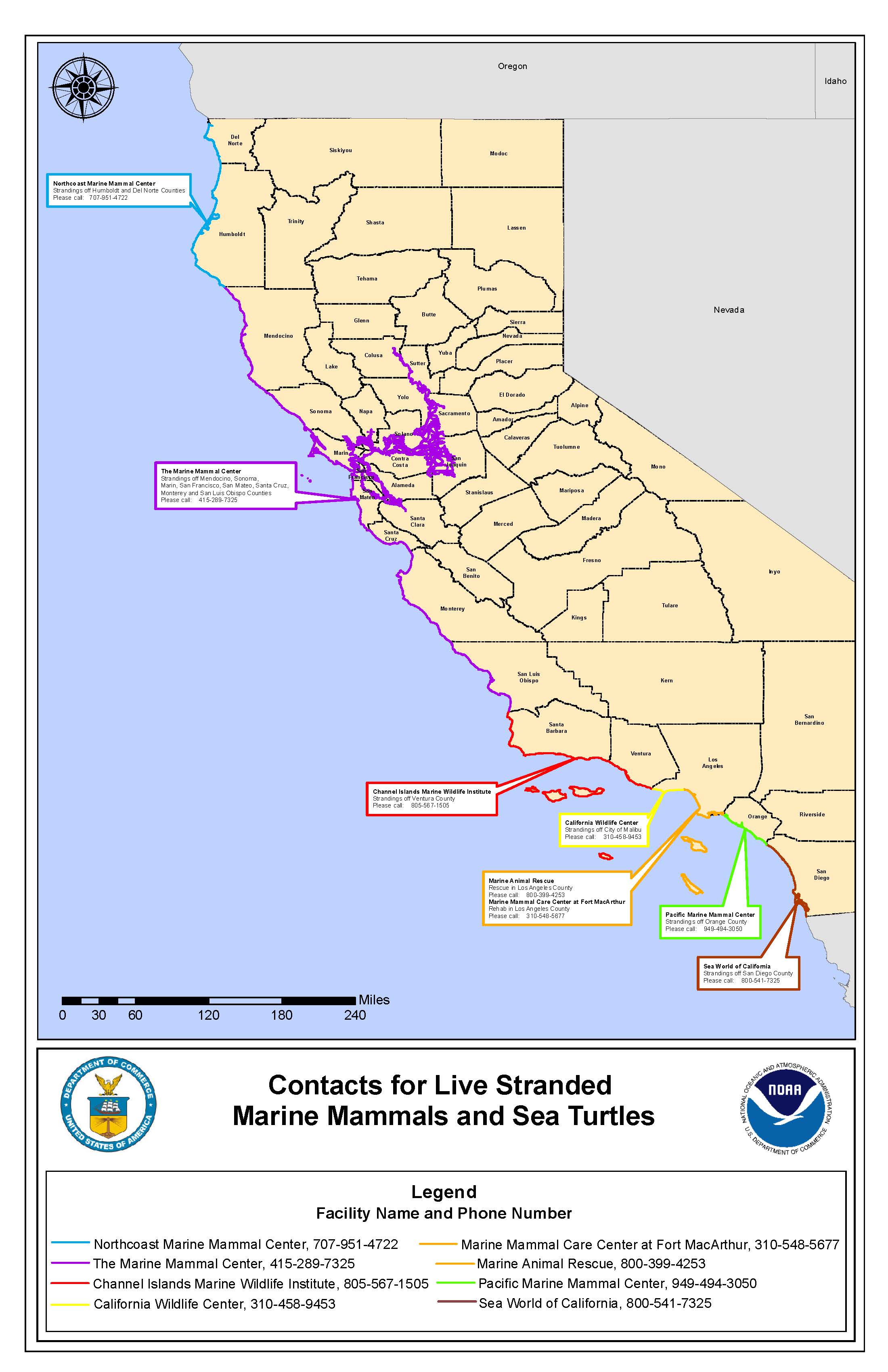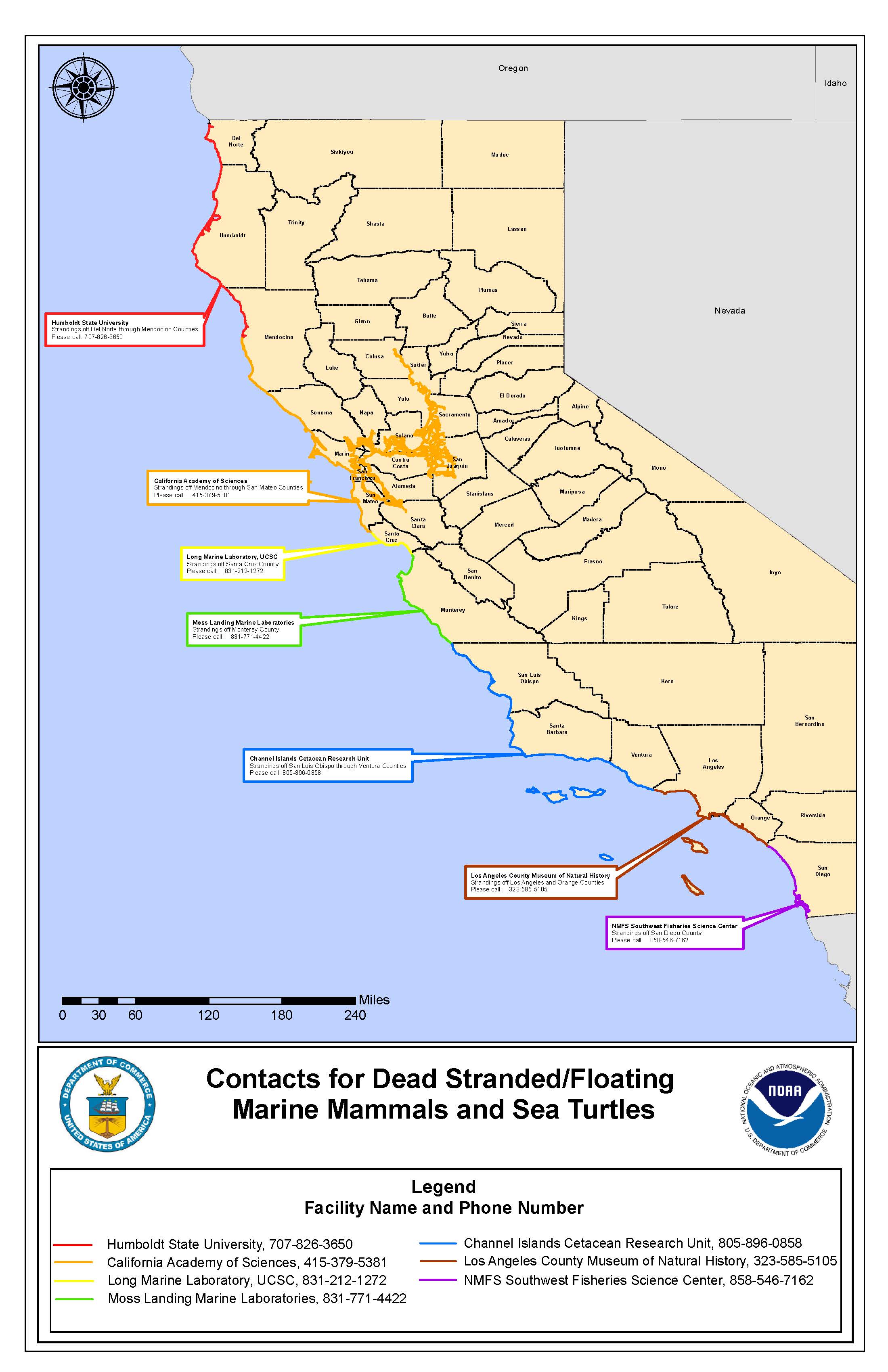NOVEMBER HIGHLIGHTS
*note: for the full suite of HAB taxa sampled weekly, see the SCCOOS and CeNCOOS HABMAP database and the Imaging FlowCytobot Dashboard.
Pseudo-nitzschia -
- C-HARM tells us where conditions are suitable for species of the diatom Pseudo-nitzschia spp. (all size classes) to grow well and where they might be more likely to produce the deadly neurotoxin, domoic acid (DA). Three independent models are run daily to produce nowcasts and three-day forecasts of the probability of a bloom, the probability of a DA event for particulate DA only, and the probability of a DA event for the cellular portion of DA only. Here, in the bulletin, we summarize nowcasts for the month.
- C-HARM predictions for Pseudo-nitzschia spp. blooms in November intensified, indicating vast statewide potential for large blooms, sometimes extending very far offshore north of Pointt Conception. This suggests a large percentage of false positives but also corroborates something we've seen for a while in the California Current, which is that conditions are fairly regularly conducive in most coastal zones to supporting Pseudo-nitzschia populations.
- HABMAP weekly pier sampling indicated moderate to low Pseudo-nitzschia spp. activity in the nearshore environment, in keeping with recent trends at the piers. However, bloom levels were reached at several locations in November: Monterey Wharf in late Nov, Cal Poly Pier in early Nov, and Santa Monica Pier in mid Nov. No clear southward or northward bloom trajectory emerges from this pattern.
- Pseudo-nitzschia activity from CDPH coastal sampling in November, however, detected the more toxigenic size class, Pseudo-nitzschia 'seriata,' as 'Abundant' at northern California sites near Klamath River and Humboldt Bay (similar to October) and "Common" at mostly northern California sites as well as Diablo Cove (San Luis Obispo), just as in October. The most consistently observed HABMAP site in northern California, Bodega Marine Lab, only detected low densities of Pseudo-nitzschia cells in November.
- A selection of CA Imaging FlowCytobot Network images from the piers in November illustrates some interesting latitudinal gradients from north to south. Imagery from Cal Poly Humboldt at a buoy in the bay reveals quite a few Pseudo-nitzschia, consistent with the CDPH measurements, co-existing with a mixed assemblage of diatoms and silicoflagellates. Moving further south, the IFCB at Santa Cruz Wharf detected a significant Akashiwo sanguinea and Maragalefidinium bloom (both potentially HAB forming dinoflagellates). Interestingly, the IFCB on the MBARI Power Buoy offshore of the SC Wharf in Monterey Bay detected a different community, one with a more even distribution of dinoflagellates and diatoms, including Pseudo-nitzschia. Further south in Orange County, the IFCB at Newport Beach Pier captured a mixed assemblage of dinoflagellates with very few Pseudo-nitzschia, consistent with HABMAP manual sampling at that site. At Scripps Pier in San Diego, the IFCB also captured a mixed dinoflagellate assemblage but one mostly dominated by Ceratium (Tripos) furca and Lingulodinium polyedra, both of which can produce "red tides" and create bioluminescence. Last month's bulletin discussed the possible encystment event of L. poly cells recorded by the IFCB. Expert analysis by Prof Emeritus Mike Latz at SIO refutes this idea and supports the alternative hypothesis that those were cells of Fragilidinium cf. mexicanum, a heterotrophic dinoflagellate that is known to prey on Lingulodinium polyedra populations (Jeong et al., 1999, Harmful Algae).
- C-HARM probabilities for particulate domoic acid (pDA) in the early part of November indicate that the greatest risk for DA exposure is the central coast from Point Conception to San Francisco Bay. Later in the month, this risk shifts to the Santa Barbara Channel and further south into the Bight, with some offshore and nearshore patches showing very high pDA probabilities.
- The pattern for C-HARM predictions of cellular domoic acid (cDA) probability shows the most intense risk in central California, as with pDA, but with a persistently elevated risk throughout the month. Patches of the coastal zone north of San Francisco Bay in Marin and Sonoma Counties also turned on and off in terms of high cDA risk. While cDA probabilities were generally low in the Southern California Bight in November, they did increase towards the end of November, aligning with the trend in pDA probabilities.
- The only HABMAP site with already analyzed DA samples (Santa Cruz Wharf) did not detect any DA in November. As noted in the previous bulletin, the strong decoupling with offshore DA was quite apparent during the recent marine mammal mortality event. We now know that that event was driven by high offshore and subsurface DA levels and resulted in incredibly high (possibly record-breaking) DA levels in animal tissue collected from stranded animals.
- Consistent with the high DA risk predicted by C-HARM for the central coast, there was one stranding case from DA toxicosis in Santa Cruz, joining the four reported last month by TMMC from Santa Cruz, Monterey, and San Luis Obispo Counties. This is consistent with IFCB images of Pseudo-nitzschia in the middle of Monterey Bay but inconsistent with the low P. "seriata" size class and DA encountered at the Santa Cruz Wharf. Two more animals stranded with suspected DA toxicosis later in the month in the LA area, which aligns with C-HARM predictions for pDA and the bloom activity for Pseudo-nitzschia spp. detected at Santa Monica Pier in mid-Nov.
- CDPH issued a sport-harvested razor clam health advisory for domoic acid in Del Norte County on November 3rd, which remains in effect. Given the low depuration (detox) rates of razor clams, DA levels in razor clams are usually more a reflection of long-term exposure to DA rather than real-time or recent bloom conditions. However, since this same advisory was lifted in June and then reinstated in November of this year, there has likely been persistent, if low-level, production of DA in the North Coast region. Both CDPH and the IFCBs have been detecting Pseudo-nitzschia spp. in Humboldt Bay and on the North Coast at moderate to high levels for several months. Note that the annual quarantine on consuming recreational mussels was lifted at the end of October.
Alexandrium -
- CDPH detected Alexandrium spp. at background "Present" relative abundance levels at sampling sites throughout central and northern California in November, just as in October. Meanwhile, the Paralytic Shellfish Poisoning (PSP) advisory initially issued for San Mateo County in early September and that was extended to Humboldt, Monterey, and San Luis Obispo Counties in October, was lifted for San Mateo, Monterey, and San Luis Obispo Counties on December 12th. HABMAP detected only low levels of Alexandrium at the Cal Poly Pier, Monterey Wharf, Santa Cruz Wharf, and Bodega Marine Lab.
Summary written by Clarissa Anderson on 16 December 2022
Note that data for some stations are not shown because they are not yet recorded in the public HABMAP archive.
Differentiating Pseudo-nitzschia species by light microscopy is difficult. For this reason, Pseudo-nitzschia "seriata" does not refer to an actual species but rather the larger size class of Pseudo-nitzschia, which is generally a more toxigenic group of species. Alternatively, Pseudo-nitzschia "delicatissima" refers to the smaller size class that is generally non-toxigenic. The dashed line on the plots demarcates the 10,000 cells/L "bloom" threshold designated here for Pseudo-nitzschia populations only.
More information and data visualizations on the statewide HAB network and forecasting system can be found on the California HABMAP website and on the SCCOOS Harmful Algal Bloom page.
Four water samples were collected at the Bodega Marine Lab shore station in November. Pseudo-nitzschia "delicatissima" was detected three times (November 9, 21, 28), all below the bloom threshold. Pseudo-nitzschia "seriata" was also detected three times (November 9, 14, 21), all below the threshold. Alexandrium spp. were detected on November 14, 28. Domoic acid results are pending.
The Bodega Marine Lab shore station is supported by CeNCOOS PI John Largier.
Four water samples were collected at Santa Cruz Wharf in November. Molecular probes for toxigenic Pseudo-nitzschia in the "seriata" class are conducted for this site, and was not detected, with one sample from November 2 pending. Alexandrium spp. were detected each time (November 9, 16, 30), with one sample from November 2 pending. Domoic acid was not detected, with the last sample pending (November 30).
The Santa Cruz Wharf shore station is supported by CeNCOOS PI Raphael Kudela at UCSC
Five water samples were collected at Monterey Wharf in November. Pseudo-nitzschia "delicatissima" was detected on each occasion (November 2, 9, 16, 23, 30), all below the bloom threshold. Pseudo-nitzschia "seriata" was detected on four occasions (November 2, 9, 16, 23), with the last sample exceeding the threshold. Alexandrium spp. were detected on November 2, 9, 16. Domoic acid results are pending.
Cal Poly Pier shore station is supported by PI Holly Bowers at MLML.
Four water samples were collected at Cal Poly Pier in November. Pseudo-nitzschia "delicatissima" was detected on two occasions (November 1, 8), with the first sample above the threshold. Pseudo-nitzschia "seriata" was detected once on November 15. Alexandrium spp. were detected once on November 29 and domoic acid results are pending.
Cal Poly Pier shore station is supported by SCCOOS and PI Ally Pasulka at Cal Poly.
Four water samples were collected at Stearns Wharf in November (NOT SHOWN). Pseudo-nitzschia "delicatissima" was detected once on November 8, below the bloom threshold. Pseudo-nitzschia "seriata" was detected twice (November 8, 24) below the threshold. Alexandrium spp. were not detected and domoic acid results are pending.
Stearns Wharf is supported by SCCOOS and PIs Mark Brzezinski and Libe Washburn at UCSB.
Four water samples were collected at Santa Monica Pier in November. Pseudo-nitzschia "delicatissima" and Pseudo-nitzschia "seriata" were detected twice (November 14, 28), with 'delicatissima' above the threshold on November 14. Alexandrium spp. were not detected and domoic acid results are pending.
The Santa Monica Pier shore station is supported by SCCOOS and PI Rebecca Shipe at UCLA.
Four water samples were collected at Newport Beach Pier in November. Pseudo-nitzschia "delicatissima", Pseudo-nitzschia "seriata", and Alexandrium spp. were not detected in the first sample (November 1), with the last three samples (November 7, 14, 21) pending analysis. Domoic acid was not detected.
Newport Beach Pier is supported by SCCOOS and PI David Caron at USC.
Four water samples were collected at Scripps Pier in November. Pseudo-nitzschia "delicatissima" was detected three times (November 7, 21, 28), all below the bloom threshold. Pseudo-nitzschia "seriata" was detected twice (November 7, 28), also below the threshold. Alexandrium spp. were detected once (November 21). Domoic acid was results are pending.
Scripps Pier is supported by SCCOOS and PIs Melissa Carter and Clarissa Anderson at UCSD.
CDPH observations for Pseudo-nitzschia "seriata" and Alexandrium spp.
View the interactive map and data table of California Department of Public Health (CDPH) data from January 2019 to present, developed by SCCOOS, below. Or, view CDPH Toxic Phytoplankton Observations Map with layers of Pseudo-nitzschia and Alexandrium spp. as well as other phytoplankton species observations (in the pop-up windows).
Data are provided by the Environmental Management Branch of the CDPH. Please note, starting in July 2019, CDPH moved to only reporting Pseudo-nitzschia of the seriata complex and not all Pseudo-nitzschia spp. as previously provided.
Please email CDPH at Susan.Paulukonis@cdph.ca.gov for any potential marine HAB-related illness in humans.
From November 1-30 2022, water samples were collected by volunteers and sent to the California Department of Public Health (CDPH) for analysis.
Pseudo-nitzchia "seriata" group was detected in 33 of the 60 samples:
Pseudo-nitzschia "seriata" was detected at "Abundant" density levels on 2 occasions:
- 2022-11-04 60% Wilson Creek
- 2022-11-07 50% Humboldt Bay, Indian Is. Ch.
Pseudo-nitzschia "seriata" was detected at "Common" density levels on 4 occasions:
- 2022-11-11 10% Port San Luis, Diablo Cove
- 2022-11-14 15% Humboldt Bay, Indian Is. Ch.
- 2022-11-15 15% Mendocino, Noyo Harbor
- 2022-11-28 45% Humboldt Bay, Indian Is. Ch.
Pseudo-nitzschia "seriata" was detected at "Present" density levels on 8 occasions:
- 2022-11-07 5% Tomales Bay, Lease #M430-15
- 2022-11-10 2% Goleta Pier
- 2022-11-15 2% Catalina Island, Avalon Bay
- 2022-11-15 2% Catalina Island, Avalon Bay
- 2022-11-15 3% Imperial Beach Pier
- 2022-11-16 7% Santa Monica Pier
- 2022-11-17 4% Port San Luis, Diablo Cove
- 2022-11-21 9% Humboldt Bay, Indian Is. Ch.
Pseudo-nitzschia "seriata" was detected at "Rare" density levels on 19 occasions:
- 2022-11-02 0.5% Goleta Pier
- 2022-11-05 0.5% Santa Cruz Wharf
- 2022-11-05 0.5% Palos Verdes Rocky Pt Offshore
- 2022-11-07 0.5% Mendocino, Noyo Harbor
- 2022-11-09 0.5% Pismo Pier
- 2022-11-10 0.5% Bodega Bay
- 2022-11-11 0.5% Bolsa Chica
- 2022-11-12 0.5% San Simeon Pier
- 2022-11-14 0.5% Morro Bay, Boat Launch
- 2022-11-14 0.5% Tomales Bay, Lease #M430-15
- 2022-11-15 0.5% Morro Bay, North T-Pier
- 2022-11-15 0.5% Sea Ranch
- 2022-11-16 0.5% Santa Cruz Wharf
- 2022-11-20 0.5% Pillar Point Harbor
- 2022-11-21 0.5% Tomales Bay, Lease #M430-15
- 2022-11-22 0.5% Pillar Point Harbor
- 2022-11-29 0.5% Bodega Harbor, USCG Dock
- 2022-11-30 0.5% Tomales Bay, Lease #M430-15
- 2022-11-30 0.5% Santa Cruz, Capitola Pier
Alexandrium spp. were detected in 14 of the 60 samples:
Alexandrium spp. were not detected at "Common" density levels.
Alexandrium spp. were detected at "Present" density levels on 5 occasions:
- 2022-11-04 2% San Simeon Pier
- 2022-11-07 1% Morro Bay, Boat Launch
- 2022-11-11 1% Port San Luis, Diablo Cove
- 2022-11-16 1% Santa Cruz Wharf
- 2022-11-17 1% Port San Luis, Diablo Cove
Alexandrium spp. were detected at "Rare" density levels on 9 occasions:
- 2022-11-10 0.5% Bodega Bay
- 2022-11-14 0.5% Morro Bay, Boat Launch
- 2022-11-14 0.5% Tomales Bay, Lease #M430-15
- 2022-11-15 0.5% Morro Bay, North T-Pier
- 2022-11-15 0.5% Sea Ranch
- 2022-11-16 0.5% Goleta Pier
- 2022-11-21 0.5% Tomales Bay, Lease #M430-15
- 2022-11-29 0.5% Bodega Harbor, USCG Dock
- 2022-11-30 0.5% Santa Cruz, Capitola Pier
CDPH and OEHHA Health Advisories
December 12. The California Department of Public Health (CDPH) has lifted the shellfish safety notifications today related to sport-harvested mussels, scallops, and clams in San Mateo, Monterey, and San Luis Obispo counties.
November 3. The California Department of Public Health (CDPH) is advising consumers not to eat sport-harvested razor clams from Del Norte County.
October 31. The California Department of Public Health (CDPH) announced the statewide annual quarantine on mussels taken by sport harvesters from California’s ocean waters ends at midnight on Monday, October 31, 2022, for all coastal counties except Humboldt, San Mateo, Monterey, and San Luis Obispo.
October 27. Dangerous levels of paralytic shellfish poisoning (PSP) toxins have been detected in mussels from Humboldt and San Luis Obispo counties.
September 2. The California Department of Public Health (CDPH) is advising consumers not to eat sport-harvested mussels, clams, or whole scallops from San Mateo County.
For the latest closures and updates, please visit the CDPH Health Advisories page as a central location of information related to CDPH health advisories. Also available is a map showing the current CDPH Recreational Bivalve Shellfish Advisories (see below).
The HAB-related illness workgroup has developed a new webpage for marine HAB-related illness tracking work (https://oehha.ca.gov/fish/general-info/marine-harmful-algal-bloom-hab-related-illness-tracking).
A network of Imaging FlowCytobots (IFCBs) continuously photographs particles, such as plankton, in the water. Using machine learning, plankton species can be automatically identified. This will help improve the ability to detect and respond to Harmful Algal Blooms, including the ability to assess conditions that may lead to toxin production or blooms of toxin-producing algae.
Additional images and data are available on the IFCB dashboard.
A mosaic of images from mid-November.
Domoic acid (DA) is a potent neurotoxin produced by some diatom species of the genus Pseudo-nitzschia. Species exposed to DA can result in seizures, epilepsy, cardiomyopathy, and death depending upon the ingested dose. DA toxicosis commonly occurs in California Sea Lions (Zalophus californianus), presumably due to a combination of foraging behavior and seasonal movements. The Marine Mammal Center (TMMC), Channel Islands Marine Wildlife Institute (CIMWI), California Wildlife Center (CWC), Marine Mammal Care Center Los Angeles (MMCC-LA), Marine Animal Rescue (MAR), the Pacific Marine Mammal Center (PMMC), SeaWorld, and Southwest Fisheries Science Center (SWFSC) act like an emergency room by working to rescue and rehabilitate sick and injured marine mammals, seabirds, and sea turtles.
PMMC, CIMWI, CWC, and SeaWorld did not record any strandings due to suspected domoic acid in November 2022. Results from SWFSC are pending.
November strandings due to suspected DA toxicosis occurred in the following counties:
- Santa Cruz (TMMC)
- November 8 - Subadult, male, California Sea Lion
- Los Angeles (MMCCLA)
- November 14 - Subadult, male, California Sea Lion
- November 22 - Adult, female, California Sea Lion

